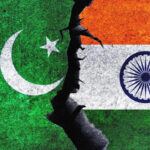With an aggressive China on one side and push from partners on the other, India faces tough choices on an Indo-Pacific maritime alliance
Parallel exercises in the Indo-Pacific this week, including a trilateral exercise between the U.S., Australia and Japan in the Philippines Sea, and an Indo-U.S. naval exercise in the Indian Ocean have fuelled speculation that Quadrilateral (Quad) exercises will be launched soon between all four navies.
All eyes are on a decision by New Delhi, to accept Australia’s request that has been pending for four years now, to join the annual Malabar exercises with India, the U.S. and Japan. The decision has not been an easy one, given China’s fierce opposition to the militarisation of a coalition seen as a counter to its claims in the Pacific and inroads in the Indian Ocean. India has also been wary of joining any exercise that could be construed as an alliance, something External Affairs Minister S. Jaishankar said this week India will “never be” a part of.
In 2018, at the Shangri-La Dialogue, Prime Minister Narendra Modi had said that India sees the Indo-Pacific as a “geographical concept”, not a “strategy or a club of limited members”. Also, India is the only country in the Quad that shares a land boundary with China, and the militarisation of the Quad will not help India deal with that threat. Fourthly, unlike the U.S., Japan and Australia, which are tied by military alliances, India is a member of other strategic forums, such as the Shanghai Cooperation Organisation with China, Russia and Central Asia, BRICS and RIC, which appear to be at cross purposes with a Quad alliance.
The China factor
Even so, many contend that China’s recent moves, including its aggression in the South China Sea and transgressions and deadly clashes across the Line of Actual Control (LAC), may in fact prove to be the tipping point that makes India take the plunge, pushing the countries of the Quadrilateral Security Group, called the Quad for short, into a military embrace that will have far-reaching implications for regional and global security.
Ironically, the Quad, which today involves such laboured and slow-paced discussions, was originally born in an instant: from the crisis that followed the tsunami in December 2004. Within days of the disaster, India had mobilised an impressive fleet, and demonstrated to the world that it would not just manage its own rescue effort in Tamil Nadu and the Andaman and Nicobar islands but could also provide assistance to its maritime neighbours: Sri Lanka, the Maldives and Indonesia.
In all, about 32 Indian ships and 5,500 troops were pressed into India’s international efforts. The humanitarian and disaster relief effort was coordinated in the next few weeks with three other naval powers engaged in the rescue effort: the U.S., Australia and Japan. The then Foreign Secretary, Shyam Saran, spoke every day to his counterparts about what was needed next. Eventually, the “Quad” effort was handed over to the UN, but the idea of the Indo-Pacific as a larger maritime strategic community, and the Quad as an effective instrument in it, had been planted in the minds of all four members.
Japanese Prime Minister Shinzo Abe, who had been promoting the idea of an “arc of prosperity and freedom” that brought the Quad countries closer together, was happy to develop the concept, and Prime Minister Manmohan Singh discussed it with him during a summit in December 2006. In 2007, when the annual India-U.S. ‘Malabar’ exercises were held in the Indian and Pacific oceans, first off Okinawa and a few months later, off Visakhapatnam, they included Japan, Australia and Singapore. The exercises and the strategic coordination in what Mr. Abe had called “the confluence of two seas” rattled Beijing and Moscow, who termed it an attempt to build “an Asian NATO”.
China’s Navy had not at the time undergone its massive modernisation drive towards a blue water navy (it only commissioned its first aircraft carrier, Liaoning, in 2012), and the effort by the Quad countries was clearly an impetus to hasten the process. But at the time, China’s demarches to the Quad countries paid off. Contrary to the currently popular lore, it was not India that cancelled the “Quad” exercises in 2008: the U.S., which was trying to gain China’s support in the six-party talks on North Korea, dampened enthusiasm for a Quad Foreign Ministers’ meeting, and the Kevin Rudd government in Australia then pulled out of the exercises. The Quad was shelved for the next decade.
In 2017, the Quad returned, now named Quad 2.0, coinciding with the revision in Washington’s assessment of the challenge from China, and similar reassessments in New Delhi, Tokyo and Canberra. In November 2017, just months after the Doklam stand-off between the Indian Army and the PLA, officials from all four countries met in Manila for the ‘India-Australia-Japan-U.S.’ dialogue. The name of the new Quad was innocuous, in an effort to dispel the notion this was a “gang-up”, and they did not even issue a common joint statement. In fact, differences within the group went deeper, and while India defined the “Indo-Pacific” region from Africa and the U.S. west coast, the U.S. limited it to the Indian coast (in 2020, the U.S. aligned its definition with India’s).
Alternatives to BRI
Subsequent meetings have closed many of the gaps they have, and the Quad grouping has met biannually since then, discussing “connectivity, sustainable development, counter-terrorism, non-proliferation and maritime and cyber security, with a view to promoting peace, stability and prosperity in an increasingly inter-connected Indo-Pacific region”. The emphasis on connectivity has seen the Quad challenge China in another sphere: a coordinated effort to provide financing and sustainable alternatives to China’s Belt and Road Initiative (BRI), which has led many nations to take loans and accept infrastructure bids from Beijing.
The counter has not yet made much headway, but each of of the Quad countries is coordinating their responses on infrastructure projects in their spheres of influence, including India and Australian efforts in the Pacific islands, India-U.S. coordination in South Asia and the Indian Ocean region, and India-Japan joint efforts to develop projects in Sri Lanka, Bangladesh and Myanmar. The military aspect of the Quad has also grown: India has strengthened its naval ties with each of the other Quad countries, and there have been more interactions, formal and informal at the official, political and military levels.
Eventually, the question over the next step in the Quad — whether India invites Australia to the next Malabar exercises or not — will be secondary to how India develops its own strategic vision, especially given the stand-off with China. Will India revert to traditional positions of non-alignment, enlisting China’s ally Russia in its attempt to manage the threat from Beijing? Or will India pursue “multi-alignment”, inviting middle powers such as the EU, the U.K., France, Russia, and partners such as Brazil, the UAE and South Africa into its Indo-Pacific strategy? Or does India’s course lie in a closer coalition with China’s adversaries, and being drawn into choosing its corner in the new Cold War that is developing between the U.S. and China? India’s moves with the Quad will be closely watched, as they bear more meaning than ever before on the path it will take to realise its strategic future.
Quad | The confluence of four powers and two seas
With an aggressive China on one side and push from partners on the other, India faces tough choices on an Indo-Pacific maritime alliance
Parallel exercises in the Indo-Pacific this week, including a trilateral exercise between the U.S., Australia and Japan in the Philippines Sea, and an Indo-U.S. naval exercise in the Indian Ocean have fuelled speculation that Quadrilateral (Quad) exercises will be launched soon between all four navies.
All eyes are on a decision by New Delhi, to accept Australia’s request that has been pending for four years now, to join the annual Malabar exercises with India, the U.S. and Japan. The decision has not been an easy one, given China’s fierce opposition to the militarisation of a coalition seen as a counter to its claims in the Pacific and inroads in the Indian Ocean. India has also been wary of joining any exercise that could be construed as an alliance, something External Affairs Minister S. Jaishankar said this week India will “never be” a part of.
In 2018, at the Shangri-La Dialogue, Prime Minister Narendra Modi had said that India sees the Indo-Pacific as a “geographical concept”, not a “strategy or a club of limited members”. Also, India is the only country in the Quad that shares a land boundary with China, and the militarisation of the Quad will not help India deal with that threat. Fourthly, unlike the U.S., Japan and Australia, which are tied by military alliances, India is a member of other strategic forums, such as the Shanghai Cooperation Organisation with China, Russia and Central Asia, BRICS and RIC, which appear to be at cross purposes with a Quad alliance.
The China factor
Even so, many contend that China’s recent moves, including its aggression in the South China Sea and transgressions and deadly clashes across the Line of Actual Control (LAC), may in fact prove to be the tipping point that makes India take the plunge, pushing the countries of the Quadrilateral Security Group, called the Quad for short, into a military embrace that will have far-reaching implications for regional and global security.
Ironically, the Quad, which today involves such laboured and slow-paced discussions, was originally born in an instant: from the crisis that followed the tsunami in December 2004. Within days of the disaster, India had mobilised an impressive fleet, and demonstrated to the world that it would not just manage its own rescue effort in Tamil Nadu and the Andaman and Nicobar islands but could also provide assistance to its maritime neighbours: Sri Lanka, the Maldives and Indonesia.
In all, about 32 Indian ships and 5,500 troops were pressed into India’s international efforts. The humanitarian and disaster relief effort was coordinated in the next few weeks with three other naval powers engaged in the rescue effort: the U.S., Australia and Japan. The then Foreign Secretary, Shyam Saran, spoke every day to his counterparts about what was needed next. Eventually, the “Quad” effort was handed over to the UN, but the idea of the Indo-Pacific as a larger maritime strategic community, and the Quad as an effective instrument in it, had been planted in the minds of all four members.
Japanese Prime Minister Shinzo Abe, who had been promoting the idea of an “arc of prosperity and freedom” that brought the Quad countries closer together, was happy to develop the concept, and Prime Minister Manmohan Singh discussed it with him during a summit in December 2006. In 2007, when the annual India-U.S. ‘Malabar’ exercises were held in the Indian and Pacific oceans, first off Okinawa and a few months later, off Visakhapatnam, they included Japan, Australia and Singapore. The exercises and the strategic coordination in what Mr. Abe had called “the confluence of two seas” rattled Beijing and Moscow, who termed it an attempt to build “an Asian NATO”.
China’s Navy had not at the time undergone its massive modernisation drive towards a blue water navy (it only commissioned its first aircraft carrier, Liaoning, in 2012), and the effort by the Quad countries was clearly an impetus to hasten the process. But at the time, China’s demarches to the Quad countries paid off. Contrary to the currently popular lore, it was not India that cancelled the “Quad” exercises in 2008: the U.S., which was trying to gain China’s support in the six-party talks on North Korea, dampened enthusiasm for a Quad Foreign Ministers’ meeting, and the Kevin Rudd government in Australia then pulled out of the exercises. The Quad was shelved for the next decade.
In 2017, the Quad returned, now named Quad 2.0, coinciding with the revision in Washington’s assessment of the challenge from China, and similar reassessments in New Delhi, Tokyo and Canberra. In November 2017, just months after the Doklam stand-off between the Indian Army and the PLA, officials from all four countries met in Manila for the ‘India-Australia-Japan-U.S.’ dialogue. The name of the new Quad was innocuous, in an effort to dispel the notion this was a “gang-up”, and they did not even issue a common joint statement. In fact, differences within the group went deeper, and while India defined the “Indo-Pacific” region from Africa and the U.S. west coast, the U.S. limited it to the Indian coast (in 2020, the U.S. aligned its definition with India’s).
Alternatives to BRI
Subsequent meetings have closed many of the gaps they have, and the Quad grouping has met biannually since then, discussing “connectivity, sustainable development, counter-terrorism, non-proliferation and maritime and cyber security, with a view to promoting peace, stability and prosperity in an increasingly inter-connected Indo-Pacific region”. The emphasis on connectivity has seen the Quad challenge China in another sphere: a coordinated effort to provide financing and sustainable alternatives to China’s Belt and Road Initiative (BRI), which has led many nations to take loans and accept infrastructure bids from Beijing.
The counter has not yet made much headway, but each of of the Quad countries is coordinating their responses on infrastructure projects in their spheres of influence, including India and Australian efforts in the Pacific islands, India-U.S. coordination in South Asia and the Indian Ocean region, and India-Japan joint efforts to develop projects in Sri Lanka, Bangladesh and Myanmar. The military aspect of the Quad has also grown: India has strengthened its naval ties with each of the other Quad countries, and there have been more interactions, formal and informal at the official, political and military levels.
Eventually, the question over the next step in the Quad — whether India invites Australia to the next Malabar exercises or not — will be secondary to how India develops its own strategic vision, especially given the stand-off with China. Will India revert to traditional positions of non-alignment, enlisting China’s ally Russia in its attempt to manage the threat from Beijing? Or will India pursue “multi-alignment”, inviting middle powers such as the EU, the U.K., France, Russia, and partners such as Brazil, the UAE and South Africa into its Indo-Pacific strategy? Or does India’s course lie in a closer coalition with China’s adversaries, and being drawn into choosing its corner in the new Cold War that is developing between the U.S. and China? India’s moves with the Quad will be closely watched, as they bear more meaning than ever before on the path it will take to realise its strategic future.






NO COMMENT